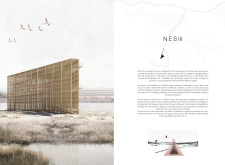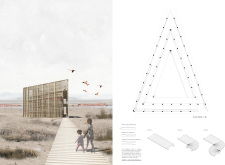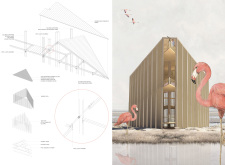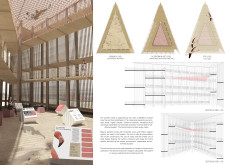5 key facts about this project
The structure features a modular triangular form that integrates seamlessly into the topography of the wetland. This design not only enhances the structural integrity but also reduces material usage. The central atrium serves as a gathering point, allowing for airflow and natural light to penetrate the interior, creating an inviting atmosphere. Elevated pathways guide visitors through the space, further emphasizing accessibility and connection to the natural surroundings.
Innovative Design Approaches
The NEB III project employs several unique design strategies that distinguish it from typical wildlife observation facilities. The use of Glu-laminated wood throughout the structure provides not only durability but also a sustainable option that aligns with the design's environmental ethos. The choice of bamboo for the ceiling offers enhanced acoustics and contributes to the light-filtering effect, providing comfort to visitors while maintaining visibility to the exterior.
The design includes strategic use of netting along observation areas, creating a safe yet immersive experience. This element allows visitors to engage more freely with the space, breaking down barriers between indoor and outdoor environments. The ramps and various levels promote exploration while also ensuring that all users, regardless of mobility needs, can access the different areas of the facility.
Functional Provision
The internal layout of the NEB III is carefully organized to facilitate educational programming and visitor engagement. The ground level comprises interactive exhibition spaces where visitors can learn about the wetland's ecology. The second level features leisure areas that encourage exploration and observation of wildlife, while the top level provides panoramic views of the reserve, creating an optimal birdwatching experience.
Significant attention has been paid to the materiality and construction methods, with a focus on sustainability and efficiency. The project showcases the potential of modern architecture to harmonize with nature, demonstrating an approach that prioritizes ecological integrity while providing functional spaces for education and observation.
For comprehensive insights into the NEB III project, including architectural plans, sections, and detailed design elements, interested readers are encouraged to explore the project presentation further. The architectural designs and innovative ideas showcased in this project reflect a commitment to advancing educational experiences within natural settings while maintaining ecological sensitivity.


























